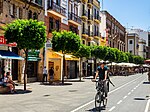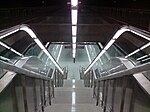Blas Infante (Seville Metro)
Railway stations in Spain opened in 2009Seville Metro stationsSpanish railway station stubsSpanish rapid transit stubs
Blas Infante is a station of the Seville Metro on the line 1. It is located at the avenue of Blas Infante, in the neighborhood of Los Remedios. Blas Infante is an underground station, located between San Juan Bajo and Parque de los Príncipes stations on the same line. It was opened on April 2, 2009.
Excerpt from the Wikipedia article Blas Infante (Seville Metro) (License: CC BY-SA 3.0, Authors).Blas Infante (Seville Metro)
Avenida Blas Infante, Seville Los Remedios
Geographical coordinates (GPS) Address External links Nearby Places Show on map
Geographical coordinates (GPS)
| Latitude | Longitude |
|---|---|
| N 37.373216 ° | E -6.010433 ° |
Address
Blas Infante
Avenida Blas Infante
41080 Seville, Los Remedios
Andalusia, Spain
Open on Google Maps











